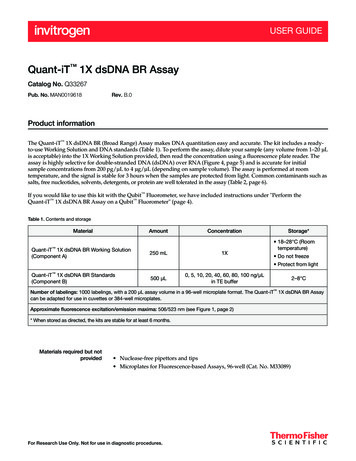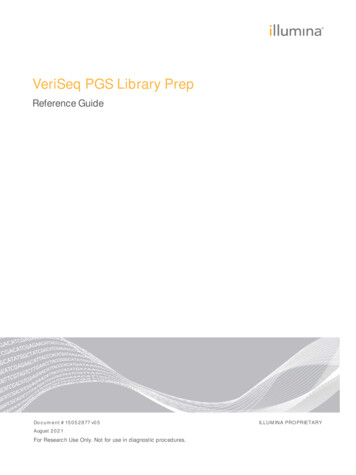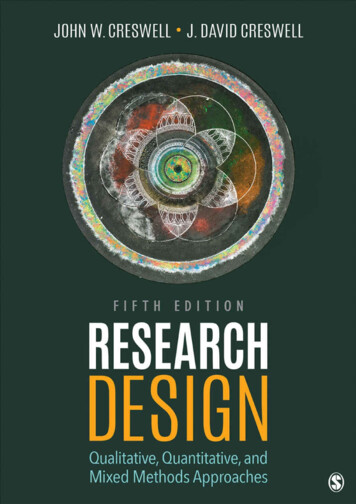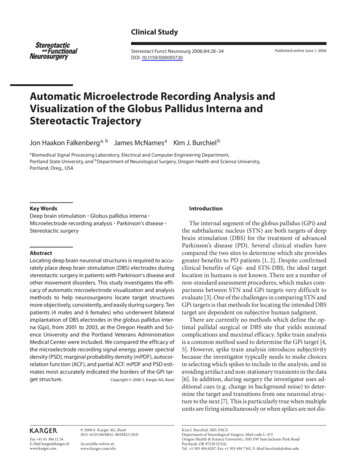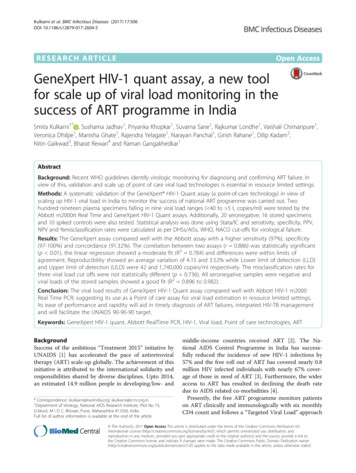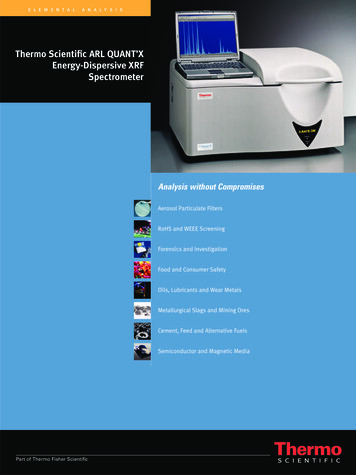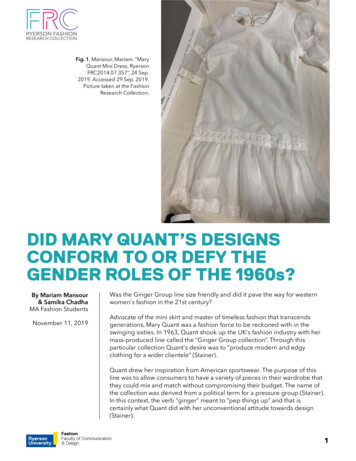
Transcription
Fig. 1, Mansour, Mariam. “MaryQuant Mini Dress, RyersonFRC2014.07.357”, 24 Sep.2019. Accessed 29 Sep. 2019.Picture taken at the FashionResearch Collection.DID MARY QUANT’S DESIGNSCONFORM TO OR DEFY THEGENDER ROLES OF THE 1960s?By Mariam Mansour& Samika ChadhaMA Fashion StudentsNovember 11, 2019Was the Ginger Group line size friendly and did it pave the way for westernwomen's fashion in the 21st century?Advocate of the mini skirt and master of timeless fashion that transcendsgenerations, Mary Quant was a fashion force to be reckoned with in theswinging sixties. In 1963, Quant shook up the UK’s fashion industry with hermass-produced line called the “Ginger Group collection”. Through thisparticular collection Quant’s desire was to “produce modern and edgyclothing for a wider clientele” (Stainer).Quant drew her inspiration from American sportswear. The purpose of thisline was to allow consumers to have a variety of pieces in their wardrobe thatthey could mix and match without compromising their budget. The name ofthe collection was derived from a political term for a pressure group (Stainer).In this context, the verb “ginger” meant to “pep things up” and that iscertainly what Quant did with her unconventional attitude towards design(Stainer).1
Fig. 2, Mansour, Mariam.“Mary Quant Mini Dress,Ryerson FRC2014.07.357”,24 Sep. 2019. Accessed29 Sep. 2019. Picturetaken at the FashionResearch Collection.Our particular dress of focus is a mini, sheer cotton dress with broderieanglaise detailing and subtle polka dot patterning. This dress, being oneof many of its kind, epitomizes the free, youthful feminine ideal that Quantintroduced with the Ginger Group collection line. It is important to note thatduring this time there was a shift in the market and the focus was on theworking girl as opposed to the prevalent socialite consumer. “The principalfocus was no longer on the well-heeled, middle-aged fashion buyer; instead,the market catered exclusively for the young, who had a more limited budget”(English 95). Quant steered the fashion scene away from “haute couture” andmade it more accessible through ready to wear designs. “She became the first‘designer’ rather than ‘couturier’ to determine the new direction in fashion(English 95).The above dress from the Ryerson Fashion Research Collection is made froma natural cotton with subtle white polka dot prints incorporated throughoutand bands of broderie anglaise embroidery on the sleeves, waistband andhem. In addition to having broderie anglaise detailing, both the sleeves andhem contain scalloped finishing on the edges (FRC2014.07.357) This dressis structured with a zipper back, sheer three-quarter balloon sleeves and amodest round neck. Moreover, the dress has a drop waist that is similar tothat of an A-line dress. The mini dress is not cinched at the waist, allowing formore mobility, making the legs the focal point of attention. The dress containslining to ensure that it is not sheer, therefore while it is playful and short, it isstill considered somewhat conservative and classic. The dress shows evidenceof wear through oil stains on the front side right above the drop waist. Also,there is what appears to be a yellow food stain on the back of the dress on theembroidered waist belt. Additionally, the yellowing of the dress indicates thatthe dress is somewhat old and worn. Alongside the dress’s inner neckline is alabel that reads “MARY QUANT’S Ginger Group” with washing instructions anda size 8 label.2
Fig. 3, Maje Dress, ile-minidress/2507222119069852?tp 149336&cm mmc ProductSearchPLACA--MAJE-DressesGoogle&gclid uHeep5c8M90l8qyWER pTXZWhile this mini dress from Quant’s Ginger Group collection conforms to somestylistic elements of the 1960’s (such as the drop waist) its short length andplayful nature blurs the line of its time period, making it look timeless. Becauseof the absence of hand-stitched techniques, it can be deduced that this dresswas sold at a mid-level price point and this is confirmed by the background wehave of this particular brand.Below is a visual comparison between a dress by Maje and Quant’s Ginger LineGroup dress. We thought it was necessary to include both as the dresses arealmost identical yet designed almost 60 years apart.3
Fig. 4, Image taken fromthe Ryerson UniversityFashion ResearchCollection catalogue.Ryerson FRC2014.07.357.Photograph by VictoriaHopgood.In this research blog post, we will discuss the following questions: Did MaryQuant’s designs conform to or defy the gender roles of the 1960’s? Was theline size friendly and lastly, did it pave the way for western women’s fashion inthe 21st century?4
MARY QUANT’S DESIGNS AND GENDER ROLES OF THE 1960sAs mentioned earlier, Quant took the fashion world by storm in the 60’s,liberating women by inspiring them to embrace fun fashion and stray awayfrom Paris’ haute couture. Furthermore, as stated by Davies in the YOUMagazine article, “Mary”,“The graphic cuts, trademark bob, coquettish eyelashes andquintessentially British style inspired a generation of women to go short,go bold and be more modern; to have fun with their fashion. I lovedthe way her designs reflected what was going on in the wider world ofpolitics, music and society – how rebellious they were.”Working women were at the forefront and through Quant’s designs, in theMarie Claire magazine article (Davies) explains that women were “freed fromrules and regulations and from dressing like their mothers.” Quant’s designsnot only served to liberate women on a superficial level but also, they reflecteda deeper, more drastic change in the way in which women behaved at a timewhen contraceptive pills were introduced in 1967 as mentioned in the YOUMagazine article, “Mary”. The miniskirt was a symbol of independence andsexual liberation and represented the newly embraced attitudes of womenwho demanded more autonomy and visibility. It came about at a time wheremore jobs were available for women and being a housewife was not the onlyoption on offer (Goldin 2). While the miniskirt movement generated a buzz,it was the cause of controversy as well. With their array of vibrant colors andunusually short hemlines, they were “considered obscene and designers suchas Coco Chanel disapproved” (Amsbaugh et al.). Women were expected toconform to the prevalent style of the time that saw more modest clothing thatwas in muted colors (Amsbaugh et al.).It was argued by Kat George in an article by REFINERY29 that rather thanserving as a tool of liberation and female empowerment, the miniskirt attracted“the male gaze and hyper-sexualized women” (George). Thus, shifting thefocus on fashion as opposed to more pressing issues such as politics ofgender parity. Additionally, feminists considered the miniskirt to be a tool ofobjectifying women and in the 1970’s they began to dispute the rise of theminiskirt (George). Today, there remains to be an ongoing debate with regardsto whether or not the miniskirt was a tool for liberating women or objectifyingthem (George). While we have come a long way from the 1960’s and womenare more sexually liberated; the issue of victim-blaming and inequality stillprevail (George). In our opinion, while we acknowledge that the dress wouldbe deemed too skimpy for the climate of the sixties, we believe that regardless,it allowed women to feel empowered and less constrained in the literal sensedue to the mobility its short length allowed. We believe that rather than servingas a tool of sex appeal, Quant’s intention was to create designs that would givewomen a voice.5
MARY QUANT’S DESIGNS’ SIZE RANGELittle to no information was given with regards to the size range of Quant’sdesigns. However, the ideal body type to wear the mini-dress was veryrestricting. It catered to women who were very young and thin- post war.Moreover, (Hall) stated that it encouraged a “dieting culture”. In The Guardianarticle “Mary Quant: Still Fresh as a Daisy” Lister explains that “for women whohad grown up during the war on a war diet, these clothes worked.” She addsthat Quant wanted to “flatter personality and loved functionality” (Kellaway).Perhaps by doing so, Quant overlooked the sizing aspects of her designs whichruled out many women. Moreover, Quant expressed that she “didn’t see a fatperson until her first trip to America in the Sixties” (Armstrong). Her inspirationbehind the miniskirt came from watching ballet dancers as a child. She furtherexpressed that while the mini skirt wasn’t physically constraining, a certain bodytype was required to pull it off. “But everyone was thin then, I didn’t get fateven when I was pregnant. You have to work very hard at staying slim and it’sa bore. But it’s worth it,” (Armstrong). Therefore, while older women and morecurvaceous women did not have the chance to embrace her designs, now onthe Victoria and Albert Museum website, women are given the opportunityto download sewing patterns that are inspired by Quant’s designs. Moreimportantly, the patterns offered are available in a wide size range, varyingfrom size 6 to 22 (Singh).Over the years Quant’s mini skirt served many purposes: from a 60’s trend,to a controversial, feminist political statement to a wardrobe staple. Today,however the mini skirt is an essential piece that can and is worn by womenof all body types. Although there was no sufficient information to be foundspecifically discussing the sizing of Quant’s designs, it can be deduced thather designs were certainly not size friendly. Moreover, judging by her views onweight, one can assume that Quant had no intention of designing clothing formore curvaceous body types. Based on our first glance of her dress, we evenconsidered that it may perhaps be childrenswear not only due to its size butalso due to the innocence evoked by the color and design.6
Fig. 5, Ashley Grahamwearing PVC on the redcarpet, Rex /celebrities-wearingvinyl-trend-and-latex.Fig. 6, Bella Hadidwearing vinyl on thered carpet, GettyImages, ies-wearingvinyl-trend-and-latex.Fig. 7, Beyoncewearing latex at the2016 Met Gala, GettyImages, ies-wearingvinyl-trend-and-latex.QUANT’S GINGER GROUP LINE AND ITS INFLUENCE ON 21st CENTURYFASHIONQuant’s Ginger Group Line influenced western women’s fashion in the 21stcentury. Along with the noteworthy miniskirt, Quant has a number of designsshe is synonymous with, including sleeveless shift dresses, tunic dresses, PeterPan collars, skinny rib sweaters as well as everyday colored tights and the iconicPVC raincoats (Hall). One cannot deny that today’s fast fashion industry giants,such as as H&M, Zara and ASOS to name but a few are following in Quant’sfoot steps after her introduction of the mass-market industry to the world.Upon opening her first boutique, Bazaar, sixty years ago, her influence remainsstrong to date amongst both high fashion brands and fast-fashion stores andthis can be seen through their designs. Although her style was simple andpractical, it was progressive for the era and remains to be remembered today.Having made a colossal contribution to the fashion world over decades of time,there are a number of exhibitions, museum shows as well as books and articleshonoring Quant as a true fashion revolutionary (Hall).Quant’s ideology of “fun and playfulness” has paved the way for many fashioninnovations such as eccentric colored tights that are an essential part ofwomen’s dress today. Moreover, the use of PVC as a material had never beforebeen used in clothing prior to Quant’s designs and today “the wet look” iscoveted by a number of celebrities on the red carpet. Quant’s influence wasso widespread that she even contributed to the beauty industry by introducingthe first ever waterproof mascara that is being worn everyday by every womanever since (Walsh). She was highly influential and her impact can be seen ineveryday clothing from back to three generations of women.7
Broderie Anglaise trend of thesummer featured in collectionsby various designers.LEFT: Fig. 8, Stella McCartneydress. oderie-anglaise-silkdress-1152433.htmlRIGHT: Fig. 9, SelfPortrait dress. /LEFT: Fig. 10, Zara 835397white-dresses-forsummer-2019/#/slide/1RIGHT: Fig. 11, H&M dress.https://www.hm.com.cn/en cn/0798087003.htmlUpon closely looking at the dress from the FRC, we have noticed that a numberof details it features are on trend now. Broderie anglaise, for example, wasconsidered the “official fabric of summer” with ASOS selling over 90,000 unitsof designs in this fabric (Teather). Moreover, the sheer fabric was the trend for2018 with different materials from light net to organza (Thakur) along with puffy/balloon sleeves trend that we have been seeing from 2018 still remaining strongin 2019 (Lanquist). The whole concept of this dress has also been reimagined in2019 as summer dresses were visible in a number of major fashion designer’scollections from high end brands such as Prada, Zimmerman and StellaMcCartney to more accessible brands such as H&M, Zara and Macy’s (Klerk).8
OUR MOODBOARDThe mood boardbelow servesto highlight ourfindings thatdresses similar toQuant’s can beseen in variousdesigner’scollections today,ranging from fastfashion brandsto high fashionbrands.9
10
Clothing, accessories even beauty have seen a vast shift between the 60’sand now because of Quant however going beyond material culture, it washer attitude that women wanted to adopt. Women yearned to be like Quant,admiring her ideology of “freedom of expression” and “the confidence to beoneself” (Walsh) and today’s woman is the epitome of that. As Quant famouslysaid “the fashionable woman wears clothes. The clothes don’t wear her”(Sagal).One cannot deny that Quant was a major driving force of change in the 1960’s.By challenging conventional norms through her playful designs she madewomen feel confident and empowered which was much needed at a timewhere women had little autonomy. However, very little is known about the flipside- the women who felt excluded because of the restricting sizing of herdesigns. While it is known that being thin was the ideal beauty standard of thetime, as evident by iconic models such as Twiggy, very little is mentioned andresearched about how women who did not live up to this ideal felt. AlthoughQuant managed to give women a voice through their way of dress and themobility her designs allowed, the irony lies in the fact that a great percentageof other women may have felt marginalized and pressured to look a certainway in order to fit the aesthetic of the time. While plus sized models andclothing are more on offer now compared to the 1960’s parallels still existthrough the selection of models at the forefront with the likes of Bella Hadidand Kendall Jenner monopolizing fashion shows and fashion campaigns.11
WORKS CITEDAmsbaugh, Charlotte, et al. “Feminist Fashion.” C Magazine, 22 Mar. n/.Armstrong, Lisa. “Mary Quant: ‘You Have to Work at Staying Slim – but It’sWorth It’.” The Telegraph, Telegraph Media Group, 17 Feb. 2012, ut-its-worth-it.html.Davies, Michelle. “Mary Quant – The Style Icon Who Changed The Face Of60sFashion.” Marie Claire, Marie Claire, 6 Mar. 2019, 46366.English, Bonnie. A Cultural History of Fashion in the 20th and 21st Centuries:from Catwalk to Sidewalk. Bloomsbury Visual Arts, 2018.George, Kat. “8 Current Fashion Trends That Had Their Roots In The FeministMovement.”Feminist Fashion Trends – No Bra Miniskirts, 22 Mar. 2018, trends#slide-1.Goldin, Claudia. “The Quiet Revolution That Transformed WomensEmployment, Education, and Family.” Vol. 96, no. NO.2, May 2006, pp. 1–21.,doi:10.3386/w11953.Hall, Harriet. “Mary Quant at the V&A Review: Revolutionary Designer IsExplored through The Women Who Wore Her Clothes.” The Independent,Independent Digital NewsandMedia, 6 Apr. 2019, -miniskirt-a8857576.html.Klerk, Amy de. “15 Summer Dresses That Will Get You through This Heatwave.”Harper’sBAZAAR, Harper’s BAZAAR, 22 July 2019, ear/news/g30493/summer-dresses/?slide 13.12
Lanquist, Lindsey. “2019 Trend Forecast: Puffy Sleeves Aren’t Going Anywhere.”StyleCaster, 5 Dec. 2018, leeves/.Mohammed, Sagal. “Mary Quant: The Designer Who Defined the 1960s andBeyond.” YOUMagazine, 5 Apr. 2019, 960s-beyond/.Singh, Anita. “Mary Quant Exhibition Has Sparked Clothes Making Boom, as30,000 People Download Free Mini-Dress Pattern.” The Telegraph, TelegraphMedia Group, 11 Oct. 2019, https://www.telegraph.co.uk/news/2019/10/11/mary- quant- Stainer, Hazel. “Quantities of Quant.” Hazel Stainer, 27 Sept. 2019, , Charlie. “Take a Breather, Denim! Broderie Anglaise Is Officially theFabric of Summer (and ASOS Sold over 90,000 Pieces Last Month).” Glamour,Glamour UK, 3 Apr. 2019, -anglaise-trend.Thakur, Vaishnavi. “BB Trend Alert–Sheer.” Be Beautiful, Be Beautiful, 10 Oct.2018, fashion-trend-2018.Walsh, Rachel Marie. “Why Mary Quant’s 60s Style Is Still as Relevant as Ever.”Irish Examiner, Irishexaminer.com, 4 Apr. 2019, le/fashion/why-mary- 7.html.13
Quant steered the fashion scene away from “haute couture” and . to download sewing patterns that are inspired by Quant’s designs. More importantly, the patterns offered are available in a wide size range, varying from size 6 to 22 (Singh). Over the years Qu

